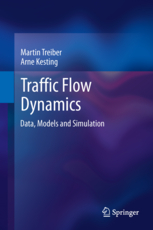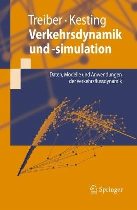
Dr. Martin Treiber's Institute Page
 |
Institute for
Econometrics and
Statistics,
particularly in Transportation
|
Research Fields
Who was not yet amazed by
traffic jams or stop-and-go waves, seemingly
appearing ''out of nothing'', without any obvious cause?
We investigate these instabilities and other aspects
of nonlinear traffic dynamics by developing and
simulating mathematical models:
- Microscopic traffic models describe the motion of
each individual vehicle. This has some analogy to multi-particle
models of physical systems.
- Macroscopic models describe the dynamics of locally
averaged quantities like the density of vehicles,
speed, and speed variance.
The corresponding equations have some analogies to the
Navier-Stokes equations of fluid dynamics. In our case,
the analogy can be stressed even further: The equations of
our models were derived from a kinetic equation
The results should help prevent at least some
of the traffic jams
by providing effective algorithms for a dynamical, i.e.,
traffic-dependent control of
- speed limits
- overtaking restrictions
- green phases of street lights in cities
- ramp metering
Further applications of traffic flow modeling include
- providing the vehicular movement background
for scientific traffic simulators used in psychological
investigations of the driving behaviour, or for
realistic hardware-in-the-loop testing of vehicle-to-vehicle
communication protocols,
- assessing the impact of novel driver-assistance systems (such as
adaptive-cruise-control) on the efficiency of traffic flow
- model-based traffic-state recognition and prediction for
improving the reliability of dynamic routing recommendations, or
modern traffic-dependent navigation systems,
- simulating fuel consumption and emissions in different
situations. For example, a traffic jam may increase the travel times
by a factor of three while the increase in CO2 emissions
may be less than 50%.
|
 |
M. Treiber and A. Kesting
Traffic
Flow Dynamics
Springer, 2013, XII+503 pages,
194 illus. (54 in color), hardcover
ISBN: 978-3-642-32459-8
Significantly expanded from
the
German textbook
Book Homepage
|
 |
M. Treiber und A. Kesting
Verkehrsdynamik und -simulation:
Daten, Modelle und Anwendungen der Verkehrsflussdynamik
Springer-Lehrbuch, 2010, XII, 368 S. 176 Abb., 56 in Farbe., Softcover
ISBN: 978-3-642-05227-9
|
|
See also the Author's Website with simulations (German)
|
|
Examples
You can get information about the actual progress
by looking at my recent
publications.
To get an impression,
simulate two-lane traffic with a continuous "microscopic"
model.
You will see, how the interplay of perturbations and bottlenecks
together with a high traffic flow
will cause various types of traffic breakdowns.
|
Martin Treiber
( )
Impressum )
Impressum
|




 )
Impressum
)
Impressum